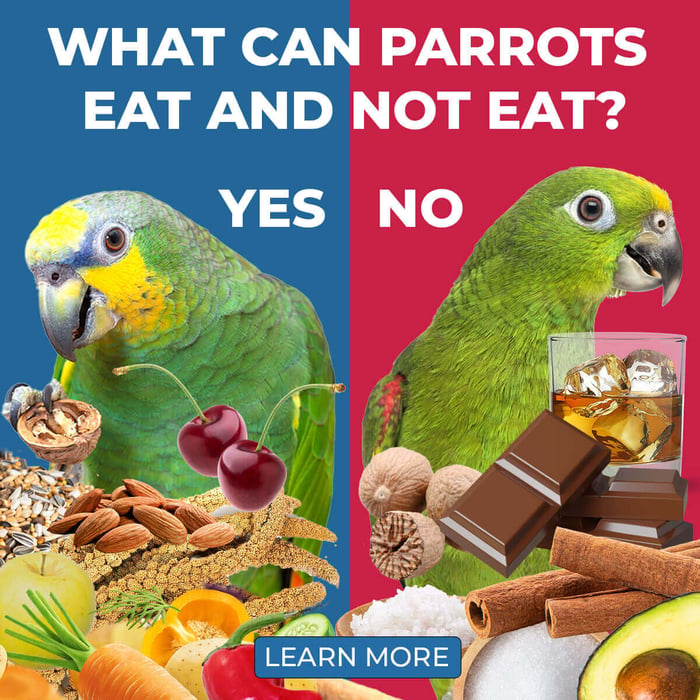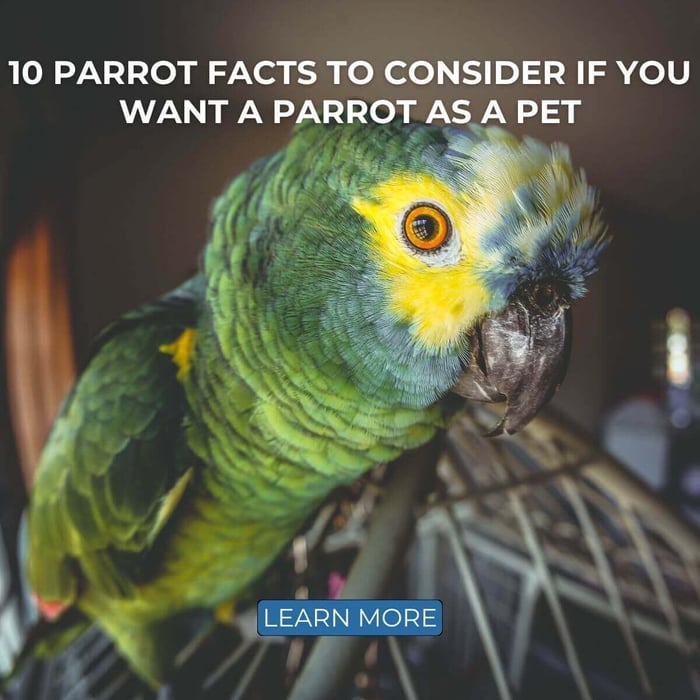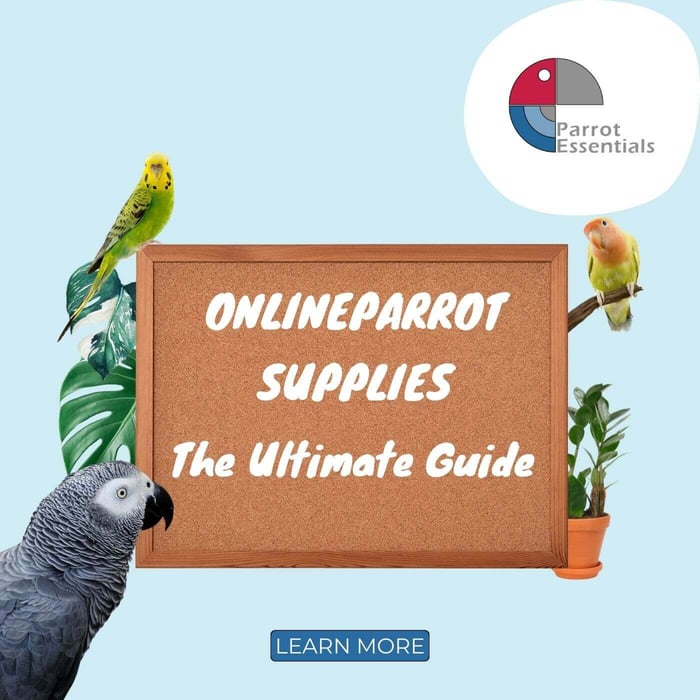What Do Parrots Eat? - Parrot Diet Plan
If you’re thinking of getting a parrot or if you’re trying to improve your feathered friend’s diet, it’s pretty easy to get overwhelmed. There are so many foods and brands out there! What do parrots eat? We all know a healthy diet is important, but what does that mean for a bird?
Fear not: it doesn’t have to be complicated. We came up with a simple diet plan for you to use as a basic guideline.
| Parrot Pellets | 75% |
| Fresh Produce & Sprouts | 15 - 20% |
| Seeds | 5 - 10% |
| Treats | Max 5% |
With this simple parrot diet plan, you can be sure you’re feeding your bird a healthy diet. Just make sure to vary daily meals and choose high-quality products.

Parrot pellets: Complete parrot food
High-quality pellets are a complete parrot food that makes for a much better staple than the classic seed mix. Scientific research on pet food can be biased due to grants from pet food companies, but the evidence in favour of pelleted parrot foods is pretty solid.
For one example, in a 2012 study, author Brightsmith found that Amazon parrots fed a diet of 75% pellet foods and 25% fresh produce and consumed a healthy mix of all necessary nutrients without ingesting too much fat. As long as you also feed fresh vegetables and fruit (see below), pellets make for a fantastic staple food for your bird.
How many pellets your parrot should be eating a day depends entirely on its weight. This is important: parrots are commonly overfed, with owners leaving food in their bowls all day. Malnutrition and obesity are huge problems in domestic parrots, so avoiding overdoing them is important. Whip out those scales to make sure how much your bird should be eating in a day!
Tip: It’s best not to give your parrot all of its food for the day at once. In the wild, many species forage in the morning and again in the evening before sunset. This is a routine you could mimic in the home, though be sure to shake things up once in a while just to prevent boredom.

Example
As a general rule of thumb, you can assume that what do parrots eat is somewhere around 10-20% of their body weight a day. If we do a little calculation using the author’s relatively small cockatiel, which weighs 80 grams, it will look something like this:
- 20% of 80 grams is 16 grams.
- Because around 75% of the bird’s diet should consist of pellets, I can feed him about 12 grams of pellets a day.
There’s a wide variety of pellet brands out there. Try Harrison’s, Askio Nature, TOP’s or one of the many other high-quality pellets in our section of complete parrot foods.
Tip: It can be hard to get your parrot to accept pellets at first. Have a look at the article on converting a parrot to pellets for tips.
Vegetables, fruits and sprouts
If around three-quarters of our feathered friend’s diet should consist of pellets, then what should the rest be? What do parrots eat aside from pellets? Actually, there are loads of choices.
As mentioned in our previous articles, pellets can be supplemented with fresh vegetables, fresh fruits, sprouted seeds and even foraged pesticide-free wild foods (which we’ll discuss at the bottom of this article).
We’d say it’s all about making things fun in this department. Foraging is a natural parrot behaviour and is very important in keeping them engaged. It helps prevent boredom and related issues like aggression and feather plucking, so it presents supplemental foods in different ways. You can find inspiration in the articles on parrot foraging.

Try making fresh produce and sprouts about 15-20% of your parrot’s diet. If your bird isn’t convinced at first, keep trying: many are raised on a pure seed diet, so they can struggle to recognize vegetables and fruits as food. Try different options and presentations, and be persistent. They’ll catch on eventually.
Tip: Vegetables are better for your bird than fruits. This is because fruits cultivated for human consumption are often very sugary. Compare that to the starchy, unripe fruits that parrots will consume in the wild!
Seeds
Although seed mixes are traditionally used as staples for parrots, it has become clear that our birds can’t live off dry seeds alone. They’re high in fat, which is great for wild birds that spend a lot of time flying around but can easily become too calorie-rich for their domestic counterparts.
On top of this, dry seeds don’t contain all the (micro)nutrients a parrot needs. In the wild, these birds would eat seeds in all their stages: unripe, ripe, dried, and partially germinated. They’ll even consume young plant shoots. Compare that to a bag of no more than three or four different dried seed types!
Does the classic seed mix still have a place in our parrot’s lives now that it’s been proven it’s too fatty and nutritionally void to serve as a staple food? We’d say yes. Small quantities of seed (5-10% of your bird’s diet) should be absolutely fine. For the natural seed-eaters, like budgies and cockatiels, you could even go a little higher.

As mentioned in the article on seed sprouting, this is a great way to easily make seeds more nutritionally dense. Aside from sprouted seeds or dry seed mixes, you can also offer the occasional millet sprig. Parakeets especially will go wild for them!
Did you know? Very fatty seeds like sunflower are best used as treats only. They’re sometimes referred to as “parrot crack” because our birds can become a bit addicted to them and start refusing other foods.
Treats
A parrot with an almond is like a kid in a candy store! Our birds just love to eat things that are on the fatty or sugary side. They do have taste buds, unlike many other birds. Since many are naturally fruit eaters, they have a preference for sweet foods. And that’s fine, as long as you don’t overdo it (no more than 5% of your parrot’s diet).
Parrot treats are particularly useful for training purposes. Our birds will do anything for a nut or seed, which means that reward-based training is a fantastic way to get yours to learn new things. Check out the post on parrot facts to consider to find out how to harness the power of food to teach parrots.
Your parrot will love things like sunflower seeds, dried fruits or maybe even a fruit jelly cup! It’ll also be elated to receive most types of human foods, but this can be riskier due to the high salt content. The articles in the parrot care section can help you figure out which foods you can and can’t share with your bird.

Tip: Remember that a little goes a long way. Instead of offering a whole nut at a time, for example, consider chopping it into small pieces. This is especially important during training time because you don’t want to have to wait for your bird to finish its treat.
Extras
As we’ve mentioned, variety is incredibly important. It helps ensure your parrot gets all the (micro)nutrients it needs and can also play a big part in preventing boredom. Like with us humans, there are many, many things that parrots can eat. Even though they lean towards herbivorism, they are technically omnivores, after all. Plenty of options, so there’s no excuse not to go foraging!
Look for edible stuff outdoors in areas free of pollution or pesticides, or let your parrot sample some of the options from the kitchen cupboard. Cooked grains like whole-wheat rice, pasta, bulgur, quinoa, amaranth and many more are a perfect addition to your bird’s daily portion of fruit and veggies.
- Some other extras you can consider include:
- Herbs for parrots
- Spices for parrots
- Parrot-safe branches like willow and eucalyptus
- Garden weeds like dandelion, clover and daisy
- The occasional freeze-dried mealworm
Conclusion

Parrot nutrition is an important topic for us here at Parrot Essentials, especially considering that most of the common medical problems in pet parrots are still caused by malnutrition. Obesity, fatty liver disease and similar issues can significantly shorten a bird’s lifespan, so a healthy diet is crucial.
Make sure you feed high-quality foods in the right quantities, weigh your parrot regularly and, most importantly, don’t fall for those begging puppy eyes. Our birds are very good at acting like they’re starving, so having a solid routine in place can help you make sure yours is neither hungry nor overfed.




